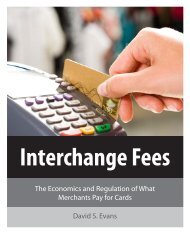Lydian Payments Journal - PYMNTS.com
Lydian Payments Journal - PYMNTS.com
Lydian Payments Journal - PYMNTS.com
Create successful ePaper yourself
Turn your PDF publications into a flip-book with our unique Google optimized e-Paper software.
In order to achieve the given goal, in June 2002 the European Payment Council (EPC) was set up. The EPC is<br />
recognized as the decision‐making and coordinating body of the European banking industry in relation to<br />
the implementation of SEPA. Its primary purpose is to support the creation of SEPA. The EPC is a selfregulatory<br />
body en<strong>com</strong>passing more than 65 European banks, including the three European credit sector<br />
associations (among them the European Associations of Corporate Treasurers) and the Euro Banking<br />
Association.<br />
The EPC’s primary deliverables are the development of SEPA Credit Transfer (SCT) and SEPA Direct Debit<br />
(SDD) “Schemes.” These schemes are a set of core inter‐bank rules, practices, and standards around which<br />
banks can <strong>com</strong>pete to offer credit transfer and direct debit products to their customers and potential valueadded<br />
services at a national <strong>com</strong>munity level. Furthermore the EPC is responsible for the development of<br />
the SEPA cards framework. This framework spells out high level principles and rules which, when<br />
implemented by banks, schemes, and other stakeholders, will enable European customers to use general<br />
purpose cards to make Euro payments and cash withdrawals throughout the SEPA area with the same ease<br />
and convenience as in their home country.<br />
EU Regulation and ECB Pressure<br />
As of 2001, the EU started to develop regulation to ensure that the vision of SEPA would be realized as the<br />
first regulation came into force. 10 At that time, the basic principle was adopted that fees applied to<br />
payments must be the same regardless of sender or recipient account location within the EU. This<br />
regulation covers card payments, cash withdrawals, and credit transfers.<br />
In 2005, after extensive discussions with the various SEPA stakeholders (banks, <strong>com</strong>panies, trade<br />
associations, and consumers), the European Commission issued its proposal for the <strong>Payments</strong> Services<br />
Directive (PSD), the underlying legal framework for the creation of an EU‐wide single market for payments.<br />
The PSD is the necessary legal framework in which all payment service providers will operate. In April<br />
2007, the European Parliament adopted the PSD proposal and it came into force on December 25, 2007. 11<br />
The first SEPA pan‐European payment instruments became operational parallel to domestic instruments<br />
on January 28, 2008. The PSD had to be transposed into the national legislation by all EU Member States by<br />
10 European Commission, Regulation 2560/2001 of the European Parliament and of the Council of 19 December 2001 on<br />
Crossborder <strong>Payments</strong> in Euro, OJ L 344, December 28, 2001.<br />
11 European Commission, Directive 2007/64/EC of the European Parliament and of the Council of 13 November 2007 on<br />
Payment Services in the Internal Market, OJ L 319, December 5, 2007.<br />
© 2009. Copying, reprinting, or distributing this article is forbidden by anyone other than the publisher or author. 9








